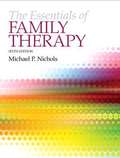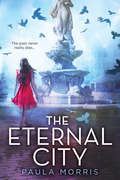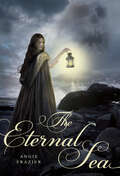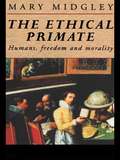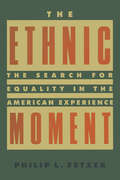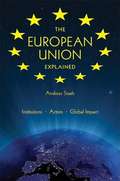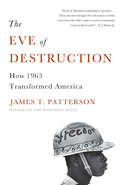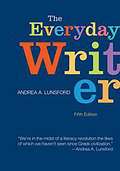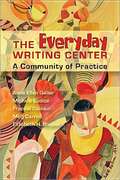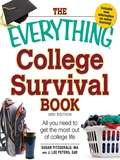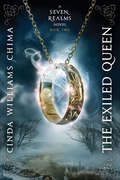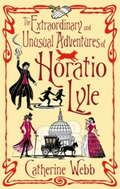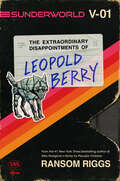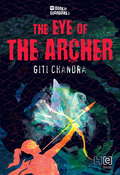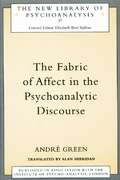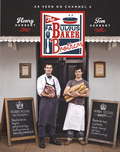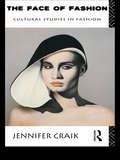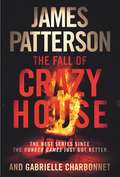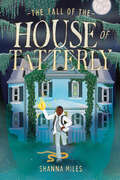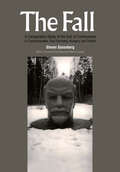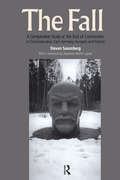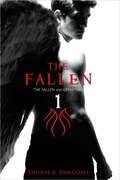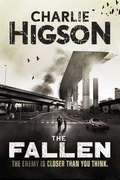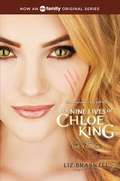- Table View
- List View
The Essentials of Family Therapy (Sixth Edition)
by Michael P. NicholsIllustrates family therapy techniques. With its clinical focus and extremely practical presentation, The Essentials of Family Therapy, 6/e examines the rich history, classic schools, and latest developments in family therapy. The sixth edition is edited to focus more on the contemporary clinical practice and case studies illustrating family therapy techniques. Written by a leading family therapist, descriptions of the various models are based on actual experience. Learning Goals Upon completing this book, readers will be able to: Utilize various family therapy techniques. Recognize the techniques of successful contemporaries in the field. Understand why research has failed to influence clinical practice.
The Eternal City
by Paula MorrisFrom master of suspense Paula Morris comes a tale of gods and goddesses, thrilling romance, and mystery set in present-day Rome.Laura Martin is visiting Rome on a class trip, and she's entranced by the majestic Colosseum, the Trevi Fountain, the Pantheon . . . Everything in this city seems magical. That is, until the magic seems to turn very dark. Suddenly, statues of Cupid and ancient works of art come to life before her eyes. Earthquakes rumble and a cloud of ash forms in the sky. A dark-eyed boy with wings on his heels appears and gives her a message. Laura soon realizes she is at the center of a brewing battle -- a battle between the gods and goddesses, one that will shake modern-day Rome to its core. Only she and her group of friends can truly unravel the mystery behind what is happening. As tensions mount and secret identities are revealed, Laura must rely on her own inner strength to face up to what may be a fight for her life. Acclaimed author Paula Morris brings the ancient world to vivid life in this unstoppable tale of friendship, love, and the power of the past.
The Eternal Sea
by Angie FrazierRomance and adventure are just around the corner . . .After the thrilling journey that led Camille through the dangerous discovery of love, secrets, and a magical stone that grants immortality, Camille has everything she wants. She's escaped the men who wanted her dead, and now she is ready to build a new life with Oscar, her one true love. But things are not to be so simple. Oscar is acting strangely, and before they can even board a ship from Australia back home, to San Francisco, Camille learns that the journey is not over. If she does not follow the magic of the curse of Umandu, her life and Ocar's could be in grave danger.
The Ethical Primate: Humans, Freedom and Morality
by Mary MidgleyIn The Ethical Primate, Mary Midgley, 'one of the sharpest critical pens in the West' according to the Times Literary Supplement, addresses the fundamental question of human freedom. Scientists and philosophers have found it difficult to understand how each human-being can be a living part of the natural world and still be free. Midgley explores their responses to this seeming paradox and argues that our evolutionary origin explains both why and how human freedom and morality have come about.
The Ethnic Moment: The Search for Equality in the American Experience
by Philip L. FetzerThis anthology focuses on the experiences of Americans whose lives have been strongly affected by the pursuit of equality in areas such as politcs, law, education and government. Each of the autobiographical essays gives voice to the writer's first personal experience of inequality.
The European Union Explained: Institutions, Actors, Global Impact
by Andreas StaabThe European Union Explained provides a concise overview of the structure, history, and policies of the European Union. Anyone who needs a quick and accessible introduction to the EU - including scholars and professionals in government, business, media, or the non-profit sector - will find this volume a valuable tool. Ideal for advanced high school and college text use, it is also useful background reading for those planning overseas study, work, or research. Drawing on many years of teaching and consulting, Andreas Staab offers basic terms and interpretive frameworks for understanding the evolution of the EU; the overall structure, purpose, and mandate of its main constituent divisions; and key policy areas, such as market unification. Andreas Staab is founder and director of the European Policy Information Centre (EPIC), a London-based training agency on the European Union. He is author of National Identity in Eastern Germany as well as articles on citizenship, democracy, and European politics.
The Eve of Destruction: How 1965 Transformed America
by James T. PattersonOf all the changes that have swept across America in the past century, perhaps none have been as swift or dramatic as those that transpired in the 1960s. The United States entered the decade still flush with postwar triumphalism, but left it profoundly changed: shaken by a disastrous foreign war and unhinged by domestic social revolutions and countercultural movements that would define the nation''s character, politics, and policies for decades to come. The prevailing understanding of the 1960s traces its powerful shockwaves to 1968, a year of violent protests and tragic assassinations. But in The First Year of the Sixties, esteemed historian James T. Patterson shows that it was actually in 1965 that America truly turned a corner and entered the new, tumultuous era we now know as "The Sixties. " In the early 1960s, America seemed on the cusp of a golden age. Political liberalism, national prosperity, and interracial civil rights activism promised positive change for many Americans. Although the nation had been shocked by the 1962 Cuban Missile Crisis and the 1963 assassination of President Kennedy, America''s fundamental traditions and mores remained intact. It was a time of consensus and optimism, and popular culture reflected this continuity. Young people dressed and behaved almost exactly as they did in the 1950s, and if the music and hairstyles of the British Invasion worried some conservative parents, these concerns were muted. At the beginning of 1965, Americans saw no indication that the new year would be any different. In January, President Johnson proclaimed that the country had "no irreconcilable conflicts. " Initially, events seemed to prove him right. The economy continued to boom, and the overwhelmingly Democratic Congress passed a host of historic liberal legislation, from the Voting Rights Act to Medicare and Medicaid to expansions of federal aid for education and the war on poverty. But Patterson shows that, even amidst these reassuring developments, American unity was unraveling. Turmoil erupted in the American South and overseas in the spring of 1965, with state troopers attacking civil rights demonstrators in Selma, Alabama and American combat troops rushing into Vietnam to protect American interests there. Many black leaders, meanwhile, were becoming disenchanted with nonviolence, and began advocating instead for African-American militancy. That summer, as anti-war protests reached a fever pitch, rioting exploded in the Watts area of Los Angeles; the six days of looting and fires that followed shocked many Americans and cooled their enthusiasm for the president''s civil rights initiatives, which--like his other "Great Society" programs--were also being steadily undermined by the costly and unpopular war in Vietnam. Conservative counterattacks followed, with Republicans like California gubernatorial candidate Ronald Reagan--and even some disillusioned Democrats--criticizing the President for mismanaging the war and expanding the federal government past its manageable limits. As Patterson explains, this growing pessimism permeated every level of society. By the end of 1965 the national mood itself had darkened, as reflected in a new strain of anti-establishment rock music by artists like the Rolling Stones, Bob Dylan, the Grateful Dead, and Jefferson Airplane. Their songs and lyrics differed dramatically from the much more staid recordings of contemporary acts like Frank Sinatra, Julie Andrews, and the Supremes, reflecting an alienation from mainstream American culture shared by an increasing number of young Americans. In The First Year of the Sixties, James T. Patterson traces the transformative events of this critical year, showing how 1965 saw an idealistic and upbeat nation derailed by developments both at home and abroad. An entire generation of Americans--as well as the country''s politics, culture, race relations, and foreign policies--would never be the same.
The Everyday Writer
by Andrea A. LunsfordAndrea Lunsfords research shows that students are writing more than ever -- in classrooms, workplaces, and social spaces, in local communities and around the world. "The Everyday Writer," Fifth Edition, is the first tabbed handbook to help the participants in this "literacy revolution" build on the smart decisions they make as social writers -- and use their skills in their academic and professional work. With Andrea Lunsfords trademark attention to rhetorical choice and language, and with new chapters on public writing, critical reading, and understanding how and why to use documentation, "The Everyday Writer" gives today's students the information they need to be effective, ethical writers. New illustrations by graphic artist G. B. Tran make complicated concepts clear and inviting for students.
The Everyday Writing Center
by Meg Carroll Anne Ellen Geller Elizabeth H. Boquet Frankie Condon Michele EodiceThe Everyday Writing Center challenges some of the most comfortable traditions in its field, and it does so with a commitment and persuasiveness that one seldom sees in scholarly discussion. The book, at its core, is an argument for a new writing center consciousness--one that makes the most of the writing center's unique, and uniquely fluid, identity. Writing center specialists live with a liminality that has been acknowledged but not fully explored in the literature. Their disciplinary identity is with the English department, but their mission is cross-disciplinary; their research is pedagogical, but they often report to central administration. Their education is in humanities, but their administrative role demands constant number-crunching. This fluid identity explains why Trickster--an icon of spontaneity, shape-shifting, and the creative potential of chaos--has come to be a favorite cultural figure for the authors of this book. Adapting Lewis Hyde and others, these authors use Trickster to develop a theme of ordinary disruptions ("the everyday") as a source of provocative learning moments that can liberate both student writers and writing center staff. At the same time, the authors parlay Etienne Wenger's concept of "community of practice" into an ethos for a dynamic, learner-centered pedagogy that is especially well-suited to the peculiar teaching situation of the writing center. Through Trickster, they question not only accepted approaches to writing center pedagogy, but conventional approaches to race, time, leadership, and collaboration as well. They encourage their field to exploit the creative potential in ordinary events that are normally seen as disruptive or defeating, and they challenge traditions in the field that tend to isolate a writing center director from the department and campus. Yet all is not random, for the authors anchor this high-risk/high-yield approach in their commitment to a version of Wenger's community of practice. Conceiving of themselves, their colleagues, student writers, and student tutors as co-learners engaged together in a dynamic life of learning, the authors find a way to ground the excess and randomness of the everyday, while advancing an ethic of mutual respect and self-challenge. Committed to testing a region beyond the edge of convention, the authors of The Everyday Writing Center constantly push themselves and their field toward deeper, more significant research, and more reflective, dynamic teaching.
The Everything® College Survival Book 3rd Edition
by MA Edd Susan Fitzgerald J. Lee PetersCollege . . . Will your classes be as fun and exciting as they sound in the course catalog? Or will you find that you need to take advantage of your professors' office hours in order to keep up? Will ramen become your only meal? Will you get along with your roommate? From handling studying and dorm life to parties and campus safety, this guide gives you straight answers to help you survive college life. Experts Susan Fitzgerald and J. Lee Peters show you how to:Ace your papers and examsDeal with loud, rude, or eccentric roommatesPrepare for financial shock--and manage student loansPlan an incredible study abroad experienceTake care of yourself and keep your sanityYou will also find tips for packing for the big move, managing your money, making new friends, and balancing academics and your social life. With The Everything College Survival Book, 3rd Edition, you'll arrive on campus less stressed, ready for fun--and poised for success!
The Exception to the Rulers: Exposing Oily Politicians, War Profiteers, and the Media That Love Them
by Amy Goodman David GoodmanHer comments turned Charlie Rose red in the face. Bill Clinton called her 'hostile, combative, and even disrespectful.' Newt Gingrich said to her, 'You're the kind of reporter I warned my mother about.' Meet Amy Goodman, award-winning journalist and host of the daily hour-long talk show that is a beacon for passionate, critical, and hard-hitting news. On subjects ranging from the deceptions of the George H. W. Bush administration to the corruption of media monopolies and corporate influence over the government, Amy Goodman attacks and exposes the lies and hypocrisy that put democracy at risk. Goodman has traveled the world reporting and speaking out in defense of human rights and offers no apologies for her advocacy. At lectures, rallies, and other public appearances, thousands turn out to hear her speak the truth. Now, in her first book, she offers her no-holds-barred perspective on world events.
The Exiled Queen: Collecting The Demon King, The Exiled Queen, The Gray Wolf Throne, And The Crimson Crown (A Seven Realms Novel #2)
by Cinda Williams ChimaNew York Times bestselling author Cinda Williams Chima presents the second installment in a thrilling new fantasy series, in which the lives of Han Alister and the brave Princess Raisa collide in a magical and dangerous adventure.Haunted by the loss of his mother and sister, Han Alister journeys south to begin his schooling at Mystwerk House in Oden's Ford. But leaving the Fells doesn't mean that danger isn't far behind. Han is hunted every step of the way by the Bayars, a powerful wizarding family set on reclaiming the amulet Han stole from them. And Mystwerk House has dangers of its own. There, Han meets Crow, a mysterious wizard who agrees to tutor Han in the darker parts of sorcery—but the bargain they make is one Han may regret.Meanwhile, Princess Raisa ana'Marianna runs from a forced marriage in the Fells, accompanied by her friend Amon and his triple of cadets. Now, the safest place for Raisa is Wein House, the military academy at Oden's Ford. If Raisa can pass as a regular student, Wein House will offer both sanctuary and the education Raisa needs to succeed as the next Gray Wolf queen.Everything changes when Han and Raisa's paths cross, in this epic tale of uncertain friendships, cut-throat politics, and the irresistible power of attraction.
The Extraordinary & Unusual Adventures of Horatio Lyle: Number 1 in series
by Catherine WebbIn Victorian London at the height of the industrial revolution, Horatio Lyle is a former Special Constable with a passion for science and invention. He's also an occasional, but reluctant, sleuth. The truth is that he'd rather be in his lab tinkering with dangerous chemicals and odd machinery than running around the cobbled streets of London trying to track down stolen goods. But when Her Majesty's Government calls, Horatio swaps his microscope for a magnifying glass, fills his pockets with things that explode and sallies forth to unravel a mystery of a singularly extraordinary nature.Thrown together with a reformed (i.e. 'caught') pickpocket called Tess, and a rebellious (within reason) young gentleman called Thomas, Lyle and his faithful hound, Tate, find themselves pursuing an ancient Chinese plate, a conspiracy that reaches to the highest levels of polite society and a dangerous enemy who may not even be human. Solving the crime will be hard enough - surviving would be a bonus...
The Extraordinary Disappointments of Leopold Berry (Sunderworld #Vol. 1)
by Ransom RiggsWeaving the familiar with the peculiar, this stunning tale of loss, triumph, friendship and magic, will remind readers everywhere that true heroes are made, not born—and when you’re never the chosen one, sometimes you have to choose yourself. <P><P> Seventeen-year-old Leopold Berry is seeing weird things around Los Angeles. A man who pops a tooth into a parking meter. A glowing trapdoor in a parking lot. A half-mechanical raccoon with its tail on fire that just won’t leave him alone. Every hallucinatory moment seems plucked from a cheesy 1990s fantasy TV show called Max's Adventures in Sunderworld—and that’s because they are. <P><P> Not a good sign. <P><P> In the blurry weeks after his mother’s death, a young Leopold discovered VHS tapes of its one and only season in a box headed for the trash—and soon became obsessed. Losing himself in Sunder was the best way to avoid two things: grieving his mother and being a chronic disappointment to his overbearing father. But when the strange visions return—at the worst possible time on the worst possible day—Leopold turns to his best friend Emmet for help. Together they discover that Sunder is much more than just an old TV show, and that Los Angeles is far stranger than they ever imagined. And soon, he’ll realize that not only is Sunderworld real, but it’s in grave danger. <P><P> Certain he’s finally been chosen for greatness, Leopold risks everything to claim his destiny, save the world of his childhood dreams, and prove once and for all that he’s not the disappointment his father believes him to be. But when everything goes terribly, horribly, excruciatingly wrong, Leopold’s disappointments prove to be more extraordinary than he ever could have imagined. <P><P> How do you battle darkness when no one believes in you—not even yourself? <P><P> Welcome to Sunderworld. <p> <b>New York Times Bestseller</b>
The Eye of the Archer
by Giti Chandra‘The worse it gets, the harder we’ll fight – it’s what we do’Deep in the cosmic centre, Yggdrasil, the battle between Edasich the Hyena, and Elrai the Good Shepherd, is not going well. The signs that warn of unmitigated destruction are everywhere, and Harish Chandra’s Clan must fight for its very life and the future of the world. Lives will be given and lives will be taken when the gods themselves join forces with the Coven, Hsimah the Fang Collector and Álfhildur, Queen of Elves, to fight the final war against the evil Edasich. Once more into the breach, the twins lead the charge – while Adit has to journey to the centre of the Earth with Vera, a powerful witch gone rogue, Akshat must bring the Book of Guardians alive. Amar and Ananya, Tarini and Noor take their powerful gifts and indomitable hearts to war, risking everything in this last stand. Meanwhile, urgent questions loom: Who will hold the centre steady when Ragnarök, the Churning of the Ocean, begins? Can their uncle H’s new avatar, the centaur, foresee the future in the stars? Does someone hold another Starstone, the repository of supreme powers? And the most terrible knowledge of all: Who is the most formidable foe on the battlefield? Spellbinding and intense, The Eye of the Archer concludes the tenacious campaign of six extraordinary young people against a fearsome force that threatens to destroy everything good, everything worth saving, everything alive.
The Fabric of Affect in the Psychoanalytic Discourse (New Library of Psychoanalysis #No.38)
by Andre GreenThe Fabric of Affect in the Psychoanalytic Discourse is a seminal work on one of the most neglected topics in psychoanalysis, that of affect. Originally published in French as Le Discours Vivant, and by one of the most distinguished living analysts, the book is structured in three parts: Affect within psychoanalytic literature Clinical practice of psychoanalysis: structure and process Theoretical study: affect, language and discourse; negative hallucination Written in a clear, lucid style, connecting theory to both culture and clinical practice, this book will appeal to psychoanalysts and psychotherapists, and also to those involved in cultural studies.
The Fabulous Baker Brothers
by Tom Herbert Henry HerbertTom and Henry Herbert - The Fabulous Baker Brothers - are fifth generation bakers with a passion for food in all its forms. Tom is a talented master baker whose famous Hobbs House Bakery sits just next door to his younger brother Henry's butchery. Together our young brothers work side by side making the amazing bread and delicious meaty accompaniments and fillings that have made their businesses so successful. Here, in this brand new cook book to accompany the hit Channel 4 show, The Fabulous Baker Brothers share with us mouthwatering oven-based recipes that unlock a world of gorgeous homemade breads, pastries, pies, cakes and confectionary. With carefully chosen ingredients and some easily-mastered techniques - this is healthy, wholesome, beautiful food that doesn't cost the earth to make. Fully illustrated throughout with photographs of the boys, their shops and Cotswold surrounds, and of course their stunning produce, this cook book gets to the fundamental heart of British good food as two of the country's most respected and successful artisans teach us how to bake like professionals in our own homes.
The Face of Fashion: Cultural Studies in Fashion
by Jennifer CraikFirst Published in 2004. Routledge is an imprint of Taylor & Francis, an informa company.
The Fall of Crazy House (Crazy House #2)
by James Patterson Gabrielle CharbonnetThe best series since The Hunger Games just got better: Escape is just the beginning in this dystopian story of two fearless sisters who must defeat a powerful regime -- or risk becoming what they despise.Twin sisters Becca and Cassie barely got out of the Crazy House alive. Now they're trained, skilled fighters who fear nothing -- not even the all-powerful United regime. Together, the sisters hold the key to defeating the despotic government and freeing the people of the former United States. But to win this war, will the girls have to become the very thing they hate?In this gripping sequel to James Patterson's New York Times bestselling YA blockbuster Crazy House, the world is about to get even crazier.
The Fall of the House of Tatterly
by Shanna MilesA captivating story about a young boy with a unique gift, perfect for fans of The Jumbies by Tracey Baptiste or Ghost Boys by Jewell Parker Rhodes. Twelve-year-old Theo Tatterly&’s ability to see ghosts is a useful skill in a house full of dead relatives, but it makes him a loner at school and everywhere else, where ghosts eternally pester him for help. For Theo, life is easier on the periphery. When his first failed exorcism portends an end to the Tatterly line, Theo must bring together his entire family—living and dead—to save the home they&’ve lived in for generations . . . and maybe the world. Author Shanna Miles&’s story of magical modern-day Charleston crackles with unforgettable characters and pays homage to the city&’s rich culture, folklore, and history. Anyone looking for ghost books for kids 9-12 or middle grade books with a supernatural twist will appreciate the immersive storytelling and integration of South Carolina's unique history in this enchanting tale.
The Fall: A Comparative Study of the End of Communism in Czechoslovakia, East Germany, Hungary and Poland
by Steven SaxonbergWith a foreword by Seymour Lipset, Hoover Institution and George Mason University, USAThe Fall examines one of the twentieth century's great historical puzzles: why did the communist-led regimes in Eastern Europe collapse so quickly and why was the process of collapse so different from country to country? This major study explains why the impetus for change in Poland and Hungary came from the regimes themselves, while in Czechoslovakia and East Germany it was mass movements which led to the downfall of the regimes.
The Fall: A Comparative Study of the End of Communism in Czechoslovakia, East Germany, Hungary and Poland
by Steven SaxonbergWith a foreword by Seymour Lipset, Hoover Institution and George Mason University, USAThe Fall examines one of the twentieth century's great historical puzzles: why did the communist-led regimes in Eastern Europe collapse so quickly and why was the process of collapse so different from country to country? This major study explains why the impetus for change in Poland and Hungary came from the regimes themselves, while in Czechoslovakia and East Germany it was mass movements which led to the downfall of the regimes.
The Fallen 1: The Fallen and Leviathan (Fallen #1)
by Thomas E. SniegoskiAaron Corbet isn’t a bad kid—he’s just a little different. And starting on the eve of his eighteenth birthday, Aaron begins to discover supernatural talents. Then he learns the truth about his destiny: He must unite angels, mortals, and Powers both good and evil, some of whom are hell-bent on his destruction.... The Fallen quartet, now published for the first time in two action-packed bind-ups, chronicles an epic struggle, where the fate of the world rests on the outcome of one teen’s monumental quest. The Fallen 1
The Fallen: The Enemy Series Book 5 (An Enemy Novel #5)
by Charlie HigsonThe Enemy is among us . . . First the sickness rotted the adults' minds. Then their bodies. Now they stalk the streets of London, hunting human flesh. The Holloway crew are survivors. They've fought their way across the city and made it to the Natural History Museum alive--just barely. But their fight will never end while the Enemy lives, unless there's another way. . . . The kids at the museum are looking for a cure. All they need are medical supplies.To get them they must venture down unfamiliar streets, where it isn't only crazed, hungry sickos who lurk in the shadows. In this fifth terrifying entry in Charlie Higson's Enemy series, suddenly it's not so clear who--or what--the enemy is.
The Fallen: The Fallen; The Stolen; The Chosen (The Nine Lives of Chloe King #1)
by Liz BraswellChloe King is a normal girl. She goes to class (most of the time), fights with her mom, and crushes on a boy…or two. But around her sixteenth birthday, Chloe finds that perhaps she isn’t so normal after all. There’s the heightened night vision, the super fast reflexes – oh, and the claws. As she discovers who she is – and where she comes from – it is clear she is not alone. And someone is trying to get her. Chloe has nine lives. But will nine be enough?
